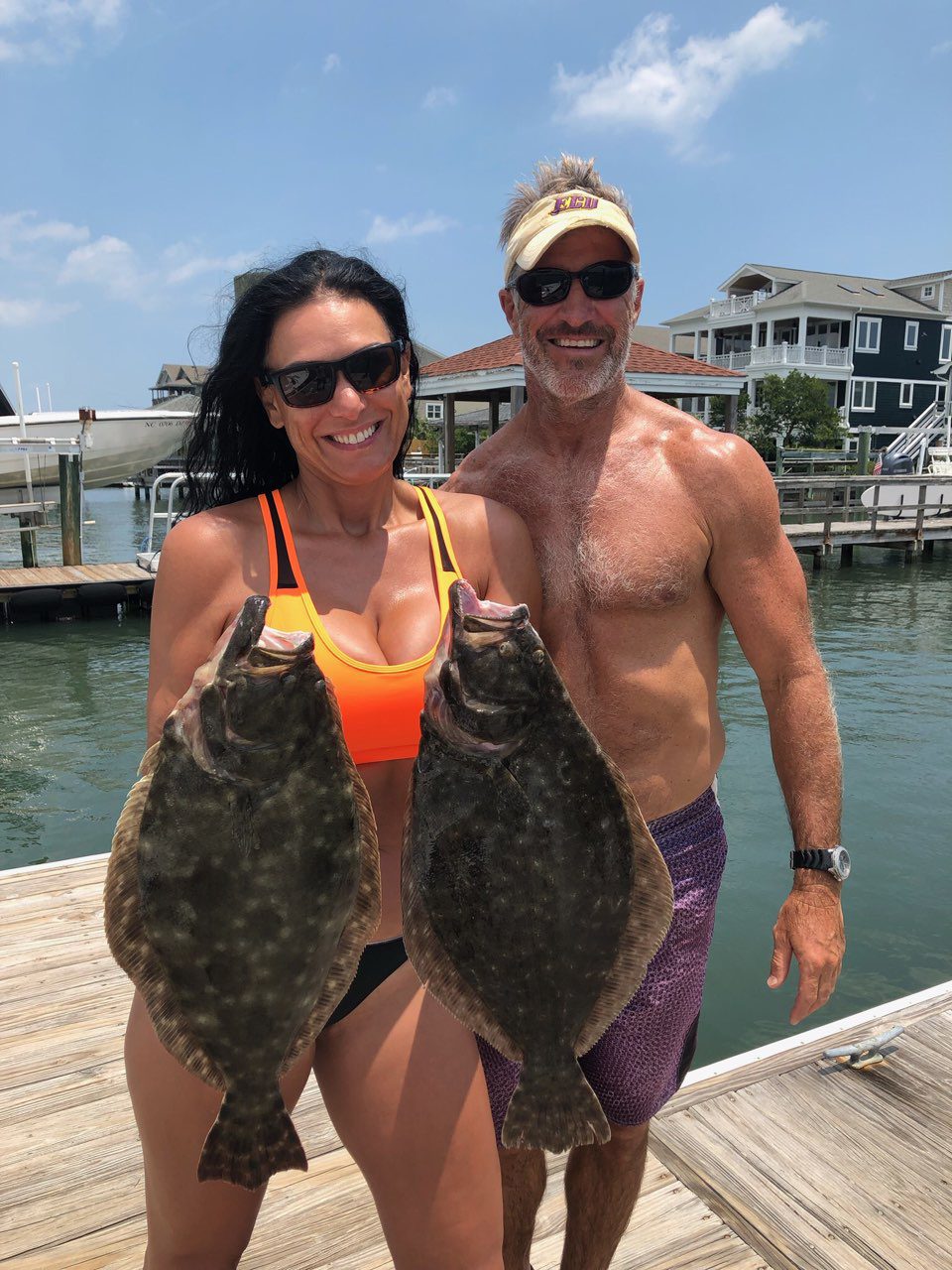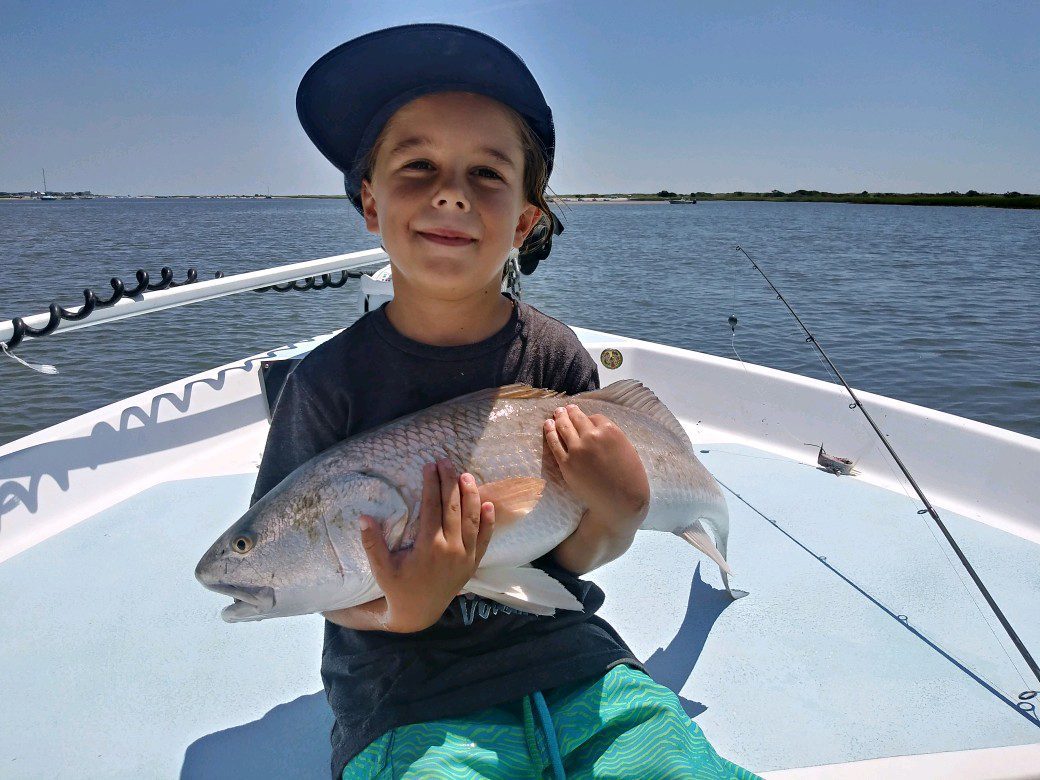Carolina Beach – July 4, 2019
Lewis, of Island Tackle and Hardware, reports that area inlets are producing plenty of red drum and flounder.
Surf anglers are landing decent numbers of pompano, while those fishing on the beach after dark are finding solid action with whiting.
Spanish are chewing hard right off the beach, with most of the action coming from the 1-3 mile range. If you head out further offshore, though, you can expect to find the larger spanish.
Even further offshore, mahi have been biting out around 20 miles.

Tracie Clarke and Mark Foster with a pair of flounder caught on spro jigs tipped with 4″ Gulp shrimp while fishing John’s Creek.
Christian, of Seahawk Inshore Fishing Charters, reports that red drum are biting, but most of the reds are holding in deeper water and shallow bays in the lower part of the Cape Fear River. The majority of the fish are lower to mid-slot, with an occasional upper-slot mixed in. Live menhaden and mud minnows are catching the most fish, with some artificial lures working as well. Fishing on the bottom with Carolina rigs will produce best, though.
Trout can be found in the mix when fishing for reds.
Flounder are eating live baits and artificials on both the incoming and the outgoing tides. Scented plastics work well, and creek mouths and shallow drop-offs seem to be holding the best numbers of flatties. Mud minnows, finger mullet, and menhaden all work great.
Spanish mackerel and bluefish are patrolling the river mouth and along the beaches. Big Nic Spanish Candies have been the top producer.
Luke, of Spot On Charters, reports that bait has been hard to find, but if you can find good-sized mullet or menhaden, then the fish are chewing. Larger mid- to upper-slot red drum are biting north in the Cape Fear River, and large flounder are biting further south. Carolina-rigged mullet or menhaden is producing the most fish.
Nearshore wrecks are holding plenty of keeper flounder, with an over-slot red drum mixed in. Occasionally, you can also catch some blues, spanish mackerel, and sea bass. Live bait will bring in the larger fish nearshore, but if live bait isn’t available, then bucktails tipped with Gulp is a good option.
Luke, of Coastline Charters, reports that red drum fishing has been great inside around docks, in creeks, and along oyster bars. There has also been a great red drum bite in the ocean, where live bottoms and structures are holding plenty of fish. Live finger mullet and Z-Man products on a Blue Water Candy jig head are the top two tactics for the redfish. Topwater baits are working well early in the morning and late in the day for the reds, too, and the topwater approach may also generate a few trout.
There is great flounder action in the ocean, and more flatfish are showing up along the ICW. Using bucktails is a good option for finding the flounder nearshore, and then live finger mullet on a Carolina rig works great for both the nearshore and the inshore flounder.
There are plenty of king and spanish mackerel hanging just off the beach. Live baits and Clarkspoons are producing.
Sheepshead fishing is strong on inshore structure, like docks and bridges. Fishing a Carolina-rigged fiddler crab works best.
Rod, of OnMyWay Fishing Charters, reports that fishing has been fantastic recently, thanks in part to a killer spanish bite right near the beach. The classic 0 or 00 Clarkspoon method has been extremely effective in 20-45’ of water outside the inlets, but primarily the fish are following the bait. Early mornings have been the most productive.
In around 5 miles and then again between 25-30 miles, you can find a lot of small (24-38”) kings. Slow trolling dead bait has been productive, and live bait is working as well.
Mahi are biting from 15 miles out and beyond, especially on wide bottom ledges and rock areas. There have also been a few weed lines in depths of 150-300’ of water, and if you can find a weed line, you’ll find the mahi. Fast trolling gold spoons on planers works, as does trolling small, pin-rigged ballyhoo on Blue Water Candy skirts in solid pink and pink/chartreuse.
Cobia are being caught while bottom fishing, especially when using live bait, in the 18-35 mile range.
Bottom fishing has been productive out to the 30 mile range, with plenty of beeliners, pink snapper, triggers, sea bass, and gags biting. The 20-40 mile range is holding red grouper and scamps.
The Gulf Stream has been hit or miss due to high water temperatures, but it’s not impossible to find sailfish, mahi, a few blackfins, and possibly a wahoo if you do your research first. Get the most up-to-date information (as in the night before and the morning of your trip) available about temperature breaks and rips, currents, and eddies, because conditions can change in an instant. Once you’re out there, look for color changes in the water. Cobalt blue water is preferable, as opposed to blue-green.

Waylon Kirkley with a 26″ red drum caught on a grub at the jetty near Masonboro Island. He was fishing with Capt. Jamie Rushing of Seagate Charters.
Woody, of Kure Beach Pier, reports that pier anglers are bringing in whiting and croakers on shrimp, along with a few red drum on cut bluefish and an occasional speckled trout.
